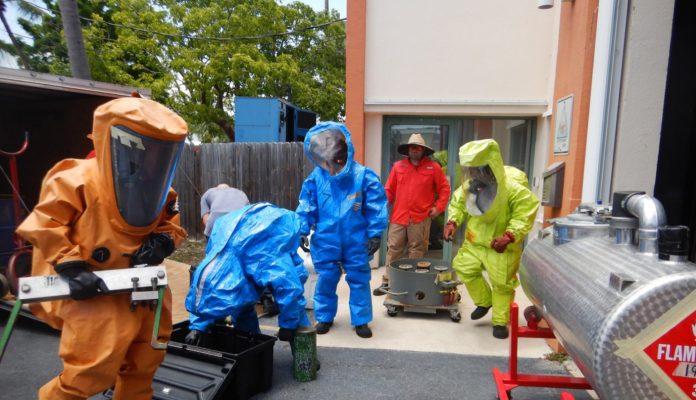Hazmat (Hazardous Materials) refers to substances or materials that pose a risk to health, safety, property, or the environment. Handling and transporting hazardous materials require specialized knowledge and skills to ensure compliance with safety regulations and to mitigate potential risks. That’s where a comprehensive hazmat training program comes into play. Whether you’re an employer or an individual seeking hazmat certification, it’s crucial to know what to look for in a hazmat training program. In this article, we will explore the key factors to consider when selecting a hazmat training program to ensure that you receive high-quality education and acquire the necessary skills to handle hazardous materials safely and efficiently.
1. Compliance with Regulatory Standards
Adherence to Regulatory Requirements
When evaluating a hazmat training program, it is vital to ensure that it complies with relevant regulatory standards. Hazmat training programs should align with regulatory bodies such as the Department of Transportation (DOT), Occupational Safety and Health Administration (OSHA), Environmental Protection Agency (EPA), and other relevant authorities depending on your location and industry.
Understanding Training Requirements
Familiarize yourself with the specific hazmat training requirements outlined by regulatory bodies. For example, the DOT mandates specific training criteria for individuals involved in the transportation of hazardous materials. Ensure that the training program covers the necessary topics and meets the minimum requirements set forth by the regulatory authorities.
Accreditation and Certifications
Check if the hazmat training program is accredited by recognized institutions or organizations in the field of hazardous materials. Accreditation ensures that the program meets established standards of quality and provides reputable and up-to-date training. Look for certifications such as ISO 9001 or ANSI/ASQ National Accreditation Board (ANAB) accreditation, which indicate that the program has undergone rigorous evaluation.
2. Comprehensive Curriculum and Course Materials
Content and Course Structure
A reliable hazmat training program such as online hazmat training by Chemtran USA offers a comprehensive curriculum that covers all essential aspects of handling hazardous materials. The course structure should be well-organized and designed to provide a systematic learning experience. Evaluate the topics covered, such as hazard identification, classification, packaging, labeling, documentation, emergency response, and regulatory compliance.
Interactive and Engaging Learning Methods
Effective hazmat training programs incorporate interactive and engaging learning methods to enhance knowledge retention. Look for programs that utilize a variety of teaching techniques such as multimedia presentations, case studies, simulations, hands-on exercises, and real-life scenarios. Interactive learning activities and assessments can help reinforce understanding and application of hazmat handling principles.
Accessible Course Materials
Ensure that the hazmat training program provides easily accessible course materials. This may include training manuals, reference guides, online resources, and support materials. Accessible and comprehensive course materials enable learners to review and reinforce their understanding of hazmat handling concepts, even after completing the training program.
3. Qualified and Experienced Instructors
Expertise and Experience of Instructors
The qualifications and experience of the instructors delivering the hazmat training program are vital factors to consider. Look for programs that have instructors with extensive knowledge and practical experience in the field of hazardous materials. Experienced instructors can provide valuable insights, share real-world examples, and answer questions effectively, enhancing the overall learning experience.
Trainer-to-Student Ratio
Consider the trainer-to-student ratio to ensure personalized attention and effective learning. Smaller class sizes allow for better interaction and individualized instruction, allowing learners to receive the necessary guidance and clarification on hazmat handling concepts. Ask about the maximum number of participants in a class and ensure that it aligns with your expectations.
Continual Professional Development
Find out if the hazmat training program emphasizes continual professional development for their instructors. The field of hazardous materials is constantly evolving, with new regulations and best practices emerging. Instructors who engage in ongoing professional development activities stay up-to-date with the latest trends, ensuring that learners receive accurate and current information.
4. Practical Hands-on Training
Practical Application of Skills
Hazmat training programs should incorporate practical hands-on training to allow learners to apply their knowledge in real-world scenarios. Practical exercises, simulations, and demonstrations can help participants develop the skills required to handle hazardous materials safely and effectively.
Training Facility and Equipment
Evaluate the training facility and the availability of appropriate equipment for hands-on training. A well-equipped training facility should include tools, safety gear, spill response kits, and other necessary resources to simulate realistic hazmat handling situations. The presence of proper equipment enhances the learning experience and enables learners to practice their skills in a controlled environment.
Field Training Opportunities
Consider if the hazmat training program offers field training opportunities. Field training allows participants to gain practical experience by observing and assisting with hazmat handling tasks under the guidance of experienced professionals. Field training provides valuable exposure to real-life scenarios and helps learners build confidence in their abilities.
Conclusion
Selecting the right hazmat training program is essential for individuals and organizations involved in handling hazardous materials. By considering factors such as compliance with regulatory standards, a comprehensive curriculum, qualified instructors, practical hands-on training, and access to continual professional development, you can make an informed decision that meets your specific training needs. Remember to evaluate the program’s accreditation, course structure, and training materials to ensure a high-quality learning experience. Investing in a reputable hazmat training program not only enhances safety but also ensures compliance with regulations and protects individuals, the environment, and property from the risks associated with hazardous materials.

























![“Does Everyone Hear Me OK?”: How to Lead Virtual Teams Effectively iStock-1438575049 (1) [Converted]](https://www.europeanbusinessreview.com/wp-content/uploads/2024/11/iStock-1438575049-1-Converted-100x70.jpg)






